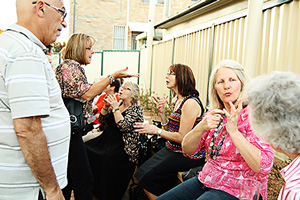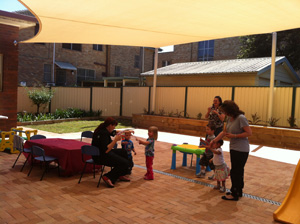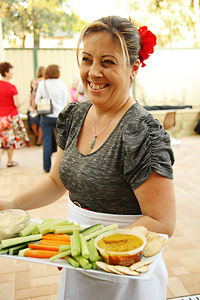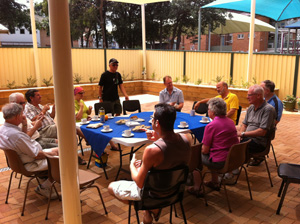
VATICAN : POPE : GOD BLESS BENIN - ARRIVAL IN AFRICA
AUSTLRALIA : EPHPHETA CENTRE OPEN AIR CELEBRATION
ASIA: TAIWAN : BISHOPS LOOK FOR NEW MEDIA OPPORTUNITIES
EUROPE: NEW CHILDREN'S BOOK ON POPE JPII
AFRICA: BENIN : 800000 CHILDREN LIVE ON THE STREETS
AMERICA: USA : 25000 YOUTH AT NATIONAL CATHOLIC CONFERENCE
TODAY'S GOSPEL AND MASS ONLINE: NOV. 18: Matthew 14: 22 - 33
TODAY'S FEAST: NOV. 18: DEDICATION OF BASILICAS STS. PETER AND PAUL
VATICAN : POPE : GOD BLESS BENIN - ARRIVAL IN AFRICA
VIS REPORTS: BENIN: TRANSITION FROM TRADITION TO MODERNITY
VATICAN CITY, 18 NOV 2011 (VIS) - This morning Benedict XVI began the twenty-second apostolic trip of his pontificate which is taking him to Benin where, on Sunday, he will sign the Post-Synodal Apostolic Exhortation of the Second Special Assembly for Africa of the Synod of Bishops. (IMAGE SOURCE: RADIO VATICANA)
The Pope departed from Fiumicino airport in Rome at 9 a.m., landing at the Cardinal Bernardin Gantin airport in Cotonou at 3 p.m. On arrival he was greeted by Thomas Yayi Boni, president of Benin, Archbishop Antoine Ganye of Cotonou, and other civil and religious authorities.
In his address, the Pope enumerated three reasons for his visit to the country: the invitation he had received from the president and the members of the Episcopal Conference of Benin, which this year celebrates the 150th anniversary of evangelisation; the signing of the Post-Synodal Apostolic Exhortation "Africae Munus", and the third "more personal and more emotive" reason of praying before the tomb of Cardinal Gantin and thanking "Benin for having given the Church such a distinguished son".
The Holy Father continued: "Benin is a country of ancient and noble traditions. Her history is significant. I am pleased to take this opportunity to greet the traditional chiefs. Their contribution is important in the construction of the country's future. I would like to encourage them to contribute, with their wisdom and understanding of local customs, in the delicate transition currently under way from tradition to modernity.
"Modernity", he added, "need not provoke fear, but neither can it be constructed by neglecting the past. It needs to be accompanied by prudence for the good of all in order to avoid the pitfalls which exist on the African continent and elsewhere, such as unconditional surrender to the law of the market or that of finance, nationalism or exaggerated and sterile tribalism which can become destructive, a politicisation of inter-religious tensions to the detriment of the common good, or finally the erosion of human, cultural, ethical and religious values. The transition to modernity must be guided by sure criteria ... rooted in the dignity of the person, the importance of the family and respect for life. All of these values exist in view of the common good which must take first place, and which must constitute the primary concern of all in positions of responsibility".
"The Church, for her part, offers her own specific contribution", the Pope concluded. "By her presence, her prayer and her various works of mercy, especially in education and health care, she wishes to give her best to everyone. She wants to be close to those who are in need, near to those who search for God. She wants to make it understood that God is neither absent nor irrelevant as some would have us believe but that He is the friend of man. It is in this spirit of friendship and of fraternity that I come to your country".
RADIO VATICANA:
Pope Benedict XVI has arrived in Benin for a three day Apostolic visit . Veronica Scarisbrick reports on his first afternoon in this West African nation :
“God Bless Benin” said Pope Benedict XVI in Fon , a local language , as he arrived in the Republic of Benin on the afternoon of Friday November 18th .
It must have been a moving moment for him as he landed at the nation’s international airport of Cotonou, the economic capital . An airport named after one he was close to for many years in the Vatican: the first sub Saharan African cardinal , Bernardin Gantin . Earlier on his way there , answering a journalist’s question on the plane he had highlighted his admiration for his former colleagues’ practical and profound intelligence and faith and even his sense of humour.
And when he was greeted by the President of the nation Mr Thomas Yayi Boni and his wife, together with civil and religious authorities , the atmosphere was warm and welcoming in true African style. And the Holy Father expressed his affection both to the Government and the local Bishop’s conference for inviting him during the year in which Benin celebrates the fourtieth anniversary of the establishment of diplomatic relations with the Holy See, as well the one hundred and fiftieth anniversary of its evangelisation.
The Pope then highlighted the broader outreach of this Apostolic journey: “This Apostolic Journey”, he stressed, “ also fulfils my desire to bring back to African soil the Post-Synodal Apostolic Exhortation Africae Munus. Its reflections will guide the pastoral activities of numerous Christian communities in the coming years. May this document set seed and take root, grow and bear much fruit “in one case a hundredfold, in another sixty, and in another thirty”, as Christ himself said .”
More broadly in his arrival speech Benedict also payed tribute to the former Kingdom of Dahomey’s ancient and noble traditions, pointing to the contribution of traditional chiefs on the path forward: “ I would like ", he said,“ to encourage them to contribute, with their wisdom and understanding of local customs, in the delicate transition currently under way from the traditional to the contemporary ”.
Finally the Pope highlighted how the Church might contribute in a specific way to that path forward: “ By her presence, her prayer and her various works of mercy, especially in education and health care, she wishes to give her best to everyone. She wants to be close to those who are in need, near to those who search for God. She wants to make it understood that God is neither absent nor irrelevant as some would have us believe but that he is the friend of man. It is in this spirit of friendship and of fraternity that I come to your country”.
Following his arrival Pope Benedict then covered the 12 kilometres to the Cathedral of Cotonou by popemobile surrounded by enthusiastic crowds, crossing the two bridges over the canal between the lagoon and Atlantic Ocean, slowly making his way towards the city’s Cathedral, an early 20th century architectural building decorated with alternate rows of burgundy and white brick. It’s dedicated to Our Lady of Mercy and when the Pope spoke he focused his attention on Mercy: “As we praise God for the marvels which he never ceases to bestow upon humanity, I invite you to meditate for a moment on his infinite mercy”.
A moment earlier he had shone the spotlight on two former Archbishops of Cotonou buried there , describing them as heroic workers in the vineyard of the Lord and pastors full of zeal and charity. On a more historical note the Holy Father did not neglect to point to the decisive role of one of these men, Archbishop de Sousa, in the country’s transition to democracy .
It was a prayerful moment, ending with a blessing and a Prayer to Our Lady of Africa , asking Her to obtain for all of humanity salvation and peace!
PV-BENIN/
AMERICA: USA : 25000 YOUTH AT NATIONAL CATHOLIC CONFERENCE

The National Catholic Youth Conference (NCYC, http://ncyc.nfcym.org/) gathered for 3 days on November 17-19. 25,000 youth have come together for this event. NCYC holds a conference every 2 years. It is organized by the National Federation for Catholic Youth Ministry(http://www.nfcym.org/).
At these conferences the youth join in prayer, Confession, Mass, Adoration of the Eucharist, Music and talks. There are dances, concerts and comedy associated with this event. The last conference was in Kansas City, Missouri with 23,000 people attending.
AUSTLRALIA : EPHPHETA CENTRE OPEN AIR CELEBRATION
Catholic Communications, Sydney Archdiocese REPORT
17 Nov 2011

Children at the Ephpheta Centre are now able
play outside in safety
This year Christmas Eve Mass for the more than 250 members of the Archdiocese of Sydney's Ephpheta Centre will be an open air celebration in the Centre's handsome new garden and outdoor covered area.
"We don't have a church of our own so holding Christmas Eve Mass here will be extra special and will also include a blessing for this wonderful new space," says Liz McDowell, administration assistant at the Centre which provides pastoral care, support, resources and a meeting point for Sydney's deaf Sydney community.
The landscaped garden and outdoor area is an initiative of the Archdiocese of Sydney, and replaces a large rough, overgrown uneven space at the Centre's Punchbowl headquarters.
With its purpose-built design, wide raised garden beds, paving, lawn, wide awning for shade and lush plantings of lilli pilli, Ephpheta's new garden and outdoor space would normally cost between $45,000 to $50,000. But thanks to Bovis Lend Lease project manager, Andrew Murphy and the generosity of tradesmen and Sydney companies, the ultimate cost came in below this figure.
"We knew the Centre had little in the way of funds, but thanks to donations of time, materials and equipment from the builders, tradesmen and consultants who had been involved with Bovis Lend Lease and the Archdiocese as part of the BER (Building the Education Revolution) scheme, we were able to create a new garden area for far less than the going rate," Andrew explains.

Raised planters double as seating in Ephpheta's
handsome new outdoor area
Although employees of Bovis Lend Lease give a day each year as volunteers on a wide number of community projects across Australia, work at the Ephpheta Centre was in addition to this, Andrew says, and gives full credit not only to his own team but the many others who helped make the handsome open space and garden at the Centre possible.
In particular he pays tribute to the Onsite group for their contribution with coordination, site management, payment of the pavers and other incidentals. Others who gave their time and skills included Riteway Carpentry, Sam the Paving Man, Nathan from Hanna Bros Plumbing & Excavations and Donna from Green Life Turn.
Sanbeep Amin of Design Inc and Alan Rose of GWA also gave support in terms of concept, structure and design.
"The space has made a huge difference to us and to our members. There has hardly been a day since it was completed we haven't used it," says Liz.
In fact less than 24 hours after the garden and landscaped outdoor area was finally completed Ephpheta was hosting a Wine and Cheese Night for 200 members to celebrate National Deaf Week.

Sign'n'tots at Ephpheta are now able to hold
meetings outside
Since then the space has been in non-stop use. Mothers and their kids who are part of the Centre's "Sign-n-Tots" group can now meet outside where the children can play as they learn to sign. The area set up with a big table is where regulars at the Centre's Coffee Club gather each month. Ephpheta's well known craft group also enjoy being outdoors as they create blankets, baby clothes, toys and cards for children's hospitals and for people in need.
"As well as the space, the awning has been fantastic and means no matter how hot, there is always shade and a place to sit," Liz says.
Before the garden and open area was constructed and landscaped, any outdoor function at the Ephpheta Centre had staff rushing to borrow shade cloths from local schools or rustling up chairs and benches.
Previously located at Flemington, the Centre was moved to its current premises at Punchbowl in April 2009.

Nicole Clark and 200 Ephpheta
members joined in the outdoor
celebrations for National Deaf Week
"We had more room but as with any move, it took a while to settle in. Then we needed another year to work out just how the Centre was being used by members and what sort of improvements might be needed," Liz says.
The project began when the Sydney Archdiocese's Community Investment Program, which seeks to identify projects that provide mutual benefits and long term sustainable links for the Archdiocese, its agencies and corporate partners, met with the Ephpheta Centre.
In turn Stephen Lawlor and his team at the Centre got together with the Archdiocese and project manager for Bovis Lend Lease, Andrew Murphy, to determine what was needed and how best they could help.
Over the next few weeks the project evolved into the design and construction of a proper level outdoor area complete with landscaping, lighting, drip irrigation and an awning to protect those using the space from harsh sun and high temperatures.

The monthly coffee club at Ephpheta enjoys the
outdoors and are protected by shade
"We wanted an outdoor area that could be used for a variety of purposes," says Nicole Clark, Interpreter for the Deaf and Assistant to Stephen Lawlor, Director of the Centre. "Many of our members travel considerable distances and for this reason we usually serve lunch after Mass. There are many other occasions where the outdoor space is particularly useful and we love that on a day to day basis, it provides a peaceful shaded area for members to spend time to sit, chat, share a coffee or cold drink and just be together."
Now with Christmas approaching, and with long summer days ahead, the outdoor space has become a favourite spot not only for members of the Ephpheta Centre but staff as well.
"We love it," says Nicole. "It's a really large area and in a few months when the lilli pilli has grown and softened the edges it will be even more beautiful. We all take turns tending the garden and enjoy all the native birds. But what we enjoy most is seeing the young ones playing in a safe area and riding their bicycles while their mothers enjoy the sunshine. And I particularly love it when there's a whole group outside, sitting around a table, laughing and signing non-stop and having the best time."http://www.sydneycatholic.org/news/latest_news/2011/20111117_1953.shtml
ASIA: TAIWAN : BISHOPS LOOK FOR NEW MEDIA OPPORTUNITIES

Catholic bishops from across Asia met this week in Hualien, eastern Taiwan, on how to harness social communication for their pastoral ministry.
Participants of the six-day meeting of the Federation of Asian Bishops’ Conferences (FABC), which finishes tomorrow, include eight bishops, eight priests and more than 12 lay and Religious ministers from 10 countries.
Father Stephen Cuyos from the Philippines, the main speaker, discussed various aspects of social media and guided the participants through the process of social networking, visual story-telling, virtual interaction and other online resources for pastoral ministry.
In his opening address, Monsignor Paul Russell, the papal representative in Taiwan, urged participants to keep updating their Church websites. Providing the latest and correct online information is necessary for effective Church works, he noted.
Bishop Wenceslao Padilla of Ulaanbaatar said that his biggest problem of evangelization in the cyberspace is not technology but the lack of Catholic terms in Mongolian. As the Mongolian Catholic Bible is still under translation, the 800 faithful have to read the Protestant Gospel during Masses.
The Mongolian Church has set up its website in the largely Buddhist country, where social media is quite commonly used, he said.
Fr Robert Leong of Brunei believed that social networking in pastoral work can help solve social problems, such as poverty gap between local people and migrant workers. His parish’s Facebook page often uploads pictures of parish activities, hoping to strengthen connections between local parishioners and Filipino Catholic workers, he said.
Bishop Joseph Luechai Thatwisai of Udon Thani said social networking is of limited use in pastoral work in northeastern Thailand, as some priests do not have a computer and many young people have left the poor area to work elsewhere.
In Taiwan, all seven dioceses have their own websites, said Chung Jin of the information section of Taiwan’s bishops’ conference. Most dioceses also promote evangelization through their blogs and Facebook pages, she added.
Next year’s meeting will be hosted by Vietnam.
http://www.ucanews.com/2011/11/18/bishops-discuss-asian-social-media/
AFRICA: BENIN : 800000 CHILDREN LIVE ON THE STREETS
EUROPE: NEW CHILDREN'S BOOK ON POPE JPII
|
TODAY'S FEAST: NOV. 18: DEDICATION OF BASILICAS STS. PETER AND PAUL

Feast: November 18
Information:
Feast Day:
November 18
The Vatican Church, dedicated in honour of St. Peter, is the second patriarchal church at Rome, and in it reposes one half of the precious remains of the bodies of SS. Peter and Paul. The tombs of the great conquerors and lords of the world have been long since destroyed and forgotten; but those of the martyrs are glorious by the veneration
 which the faithful pay to their memory.
which the faithful pay to their memory.The body of St. Peter is said to have been buried immediately after his martyrdom, upon this spot, on the Vatican hill, which was then without the walls and near the suburb inhabited by the Jews. The remains of this apostle were removed hence into the cemetery of Calixtus, but brought back to the Vatican. Those of St. Paul were deposited on the Ostian Way, where his church now stands. The tombs of the two princes of the apostles, from the beginning, were visited by Christians with extraordinary devotion above those of other martyrs. Caius, the learned and eloquent priest of Rome, in 210, in his dialogue with Proclus the Montanist, speaks thus of them: "I can show you the trophies of the apostles. For, whether you go to the Vatican hill, or to the Ostian road, you will meet with the monuments of them who by their preaching and miracles founded this church."
The Christians, even in the times of persecution, adorned the tombs of the martyrs and the oratories which they erected over them, where they frequently prayed. Constantine the Great, after founding the Lateran Church, built seven other churches at Rome and many more in other parts of Italy. The first of these were the churches of St. Peter on the Vatican hill (where a temple of Apollo and another of Idaea, mother of the gods, before stood) in honour of the place where the prince of the apostles had suffered martyrdom and was buried and that of St. Paul, at his tomb on the Ostian road. The yearly revenues which Constantine granted to all these churches, amounted to seventeen thousand seven hundred and seventy golden pence, which is above thirteen thousand pounds sterling, counting the prices, gold for gold; but, as the value of gold and silver was then much higher than at present, the sum in our money at this day would be much greater. These churches were built by Constantine in so stately and magnificent a manner as to vie with the finest structures in the empire, as appears from the description which Eusebius gives us of the Church of Tyre; for we find that the rest were erected upon the same model, which was consequently of great antiquity. St. Peter's Church on the Vatican, being fallen to decay, it was begun to be rebuilt under Julius II in 1506, and was dedicated by Urban VIII in 1626, on this day; the same on which the dedication of the old church was celebrated The precious remains of many popes, martyrs, and other saints, are deposited partly under the altars of this vast and beautiful church, and partly in a spacious subterraneous church under the other. But the richest treasure of this venerable place consists in the relics of SS. Peter and Paul, which lie in a sumptuous vault beyond the middle of the church, towards the upper end, under a magnificent altar at which only the pope says mass, unless he commissions another to officiate there. This sacred vault is called The confession of St. Peter, or The threshold of the Apostles (
